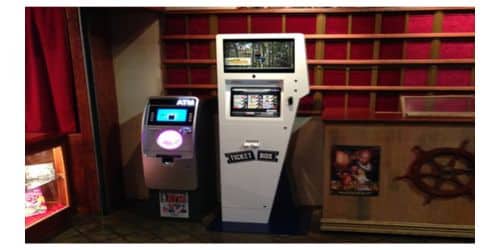Kiosks can help spread the word about a business and give customers a way to interact with it. They can also be annoying if not taken care of properly, which is bad for a brand’s reputation. In this blog post, we will explain what a kiosk means, a kiosk machine, a kiosk computer, and the kiosk application.
What Is a Kiosk
A kiosk is a small, temporary, stand-alone booth used for marketing in places with a lot of foot traffic. Most of the time, one or two people work at a stand. They help get people’s attention and bring in new customers. Most retail stands are in malls or on bustling city streets with a lot of people walking by. They give business owners a low-cost way to sell their goods or services.
Understanding Kiosks
Kiosks are usually small booths set up in places with a lot of foot traffic. You might see them on shopping center paths. They might have employees who sell toys, hair products, insurance, or credit cards, among other things.
People aren’t always watching over kiosks. Some are even automatic, so customers can do things by themselves. Most of the time, these machines are added to a service that the kiosk owner already provides. For example, some provincial governments in Canada allow people to use electronic booths that work a lot like automated teller machines (ATMs) to do things like renew their car registration or change their personal information on their health cards and driver’s licenses. This means that the customer can do these things on their own and won’t have to wait in line at a provincial office.
What Is a Kiosk Machine
A kiosk machine is used to process customer orders for goods and services. Digital stations are places where you can buy tickets, check-in at an airport, or order food at fast food and casual restaurants. Kiosk machines exist in many malls and even some places to help people find their way and to show advertisements.
Kiosk machines are seen in many different shapes and sizes, and they can be driven by smartphones, tablets, or even custom touchscreen devices. This means they can be almost any size. Digital stands are used in the following fields:
- Healthcare: Self-check-in kiosk machines at doctors’ offices and kiosks for picking up and paying for prescriptions at pharmacies.
- Restaurants: Self-ordering machines or interactive seating kiosks for front-of-house personnel
- Retail: Self-checkout machines or point-of-sale systems
- Transportation: Kiosk machine at airports and train stops for checking in and buying tickets
- Parking: Payment kiosks for parking spaces
- Directories: Large touchscreen digital signage kiosks in shopping malls for store directories and advertising.
Why Should You Use Digital Kiosks?
The best part about digital kiosk machines is that they can be automated. Consider self-service checkouts versus employee-staffed registers in retail establishments. Digital kiosk machines can also lower your business’s operating costs because they allow your workers to focus on more important tasks, like getting things done quickly and helping customers. When used as part of a bigger plan, digital kiosks can get customers more involved, bring in more money, cut costs, and make customers happier.
What Is a Kiosk Computer
A computer kiosk is just a computer with an integrated housing unit. The simplest models are usually just a regular desktop or tablet attached to a table of some kind, usually at the height of a person standing to work on it or use it. More complex models are often completely streamlined touch-screen machines, like the ones you see at airport and train station self-service check-in counters. There are many uses and variations, but most of them are made for self-service jobs, like checking out books from a library or asking for a number at a deli counter. Most kiosks come with pre-installed software made for the specific tasks the machine will do. In most cases, computers aren’t powerful enough to be used for things that aren’t related to the job at hand.
Core Components
Most people think of the interface when they think of a computer kiosk, and in many ways, this is what makes the machine what it is. In the same way, kiosks can be made in many different ways, usually depending on what they will be used for. Some are very big and have many screens and control options, while others are very small. All of them are a single unit, which is their biggest thing in common. A computer on a table isn’t usually a kiosk unless the computer and table are made to work together.
Most of the time, the only really important part of a computer is the screen. Some of the time, keyboards and mice are used, but not always. Because of changes in technology, many kiosks now use touch screens instead of the standard mouse and keyboard. This makes it even easier to use the machines and often makes it less likely that the hardware will break, which can be a big problem in places like transportation hubs and hospitals where there are a lot of people.
Main Purposes and Primary Uses of Computer Kiosk
Most kiosks are made to be “self-service,” which means that customers can use them without help, because of this, software and hardware are generally made with a lot of care to be easy to use. Most operating systems are common and easy to understand, so most people can figure out how to do things right away.
Computer kiosks range from cubicles in malls where people may apply for employment to mobile stations in hospitals. They are very useful and cut down on the amount of human interaction, which makes it easier for customers to move around and allows businesses to hire fewer people to handle customer interactions.
#1. Possibility of Mobility
Even though most computer kiosks aren’t mobile, some can be. In hospitals, nurses don’t have to take a computer with them from room to room because there are special kiosks for them. In these cases, the computers are inside a mobile stand that is about four feet tall. The monitor and keyboard of most kiosks are easy to use and reach. This usually means keeping each device at arm’s length.
#2. Security Concerns
In the early days of public computers, kiosks were a big problem for information security because bad people may hack them or steal their data. Modern software has mostly put an end to these worries, at least insofar as it is easy to lock down and limit access to information saved on and used by kiosk machines. Most of the problems people have with kiosks today have nothing to do with security breaches or data loss. As machines get older, they are more likely to stop, freeze, or drop requests in the middle of processing. Because of this, operators, especially in places with a lot of traffic, are usually smart to commit to regular repair and service to avoid problems.
What Is a Kiosk Application
People often don’t think about which application technology is best for their kiosk project, but making the right choice can be very important to the success of the project. You may be limited in your choice by the need to work with certain peripherals or by the way your company buys hardware, but we hope that by reading this, you will know more about the pros and cons of each technology and be better able to make the right choice.
In short, these are the three main tools that typically exist to make a kiosk application:
As a Standalone Application for a Pc-Based System
This can be a Chrome OS or Linux program or a full-screen Windows app.
As a Mobile App for Android or Ios That Will Run on an iPad or Tablet Device
Again, these will run full-screen with no information bars on a kiosk-mode device.
As a Browser-Based Application
Current, responsive browser-based apps that are written to meet current web standards can run on any of the above devices that have a browser set up to run in kiosk mode. Next, we’ll look more closely at each of the three choices above.
#1. Standalone Booth Apps for Pcs
As it supports many hardware devices and has been available for a long time, many self-service, touch screen, and booth apps use this. Some apps that employ devices using only Windows driver software may require a standalone Windows app. Some printers and payment devices, for example, only have reliable drivers for Windows. This means that they won’t work reliably (if at all) on Chrome OS, iOS, Android, or in a browser.
#2. Tablet Apps for Android or iOS
Tablet apps are popular for projects since one can construct Android and iOS rapidly. This is because the development environments support device peripherals like the camera and microphone “out of the box” with minimal additional code.
Due to the small number of iPad models compared to the huge number of Android-based tablets with different prices and quality, it is important to note that the reliability of Android apps is much more variable and can rely on the quality of the device. If dependability is the most important thing, it’s best to use an application for iOS or a higher-quality Android device that has been tested a lot for the intended use.
#3. Browser Applications
A browser app is exactly what its name says it is: an application that runs in a standard web browser. To make it interactive, browser apps usually use current web technologies like HTML5, Bootstrap/CSS3, and a JavaScript library like React, Angular, or Vue. PHP, Ruby, or Microsoft.Net can code the software.
Most current kiosk apps will talk to some kind of web-based dashboard, so your kiosk app may still use a browser-based app even if it uses one of the two options above.
What Is the Purpose of a Kiosk?
Businesses use kiosks to interact with clients in busy places. Kiosks are usually for selling things, and people can work them or they can be self-service.
What Are the 7 Types of Kiosk?
The Right Kiosk For You.
- Temperature Kiosk.
- Advertisement Standing Displays.
- Wayfinding Kiosks.
- Internet Kiosks.
- Self-Service Kiosks.
- Information Kiosks.
- Internet Kiosks.
What Are the Examples of Kiosk?
A few examples of digital kiosks include self-ordering kiosks in restaurants, check-in kiosks at doctor’s offices, ticketing kiosks in airports, and payment kiosks in parking garages. Other examples of digital kiosks include ticketing kiosks in airports and ticketing kiosks in airports.
Why Is It Called Kiosk?
History: The word “kiosk” comes from the Turkish word “koşk,” which originally meant an open-air pavilion or summerhouse in Turkey and Persia, which was often built on a hexagonal or many-sided base. Rich Ottomans could watch entertainment and view their grounds in these buildings.
What Are the Characteristics of a Kiosk?
A kiosk is a small construction with a digital screen or a tiny structure. Kiosks with touch screens are put in busy parts of a business to give people information or ways to help themselves. In today’s fast-paced climate, kiosks can improve retail services and client purchasing experiences.
Who Invented Kiosk?
Murray Lappe came up with the idea for the first interactive booth in 1977. “The Plato Hotline” was a way for people at the University of Illinois at Urbana-Champaign to find out things. In the 1980s, the interactive voice response unit (IVR) grew because people wanted new ways to help themselves.
Who Is a Kiosk Owner?
The Kiosk Owner is responsible for the ownership of the front-end kiosks, as well as their operation and management on a day-to-day basis as a business. This individual is essential to the success of the e-Mitra activities. The Kiosk Owner and the Service Operator are obligated to communicate with one another in order to share any pertinent information regarding the Wi-Fi equipment that is planned to be placed in the respective payphone kiosks.






